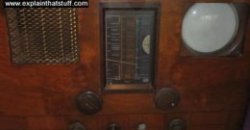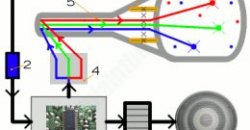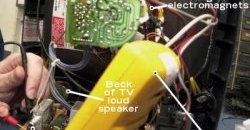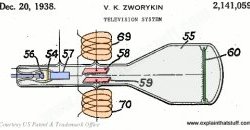Television how it works

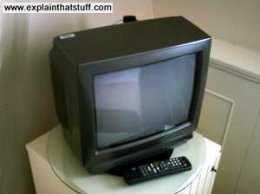 Advertisement
Advertisement
Television is a phenomenal window on the world. At the flick of a button, you can travel from the North Pole to the Serengeti, watch men walking on the Moon, see athletes breaking records, or listen to world leaders making historic speeches. Television has transformed entertainment and education; in the United States, it's been estimated that children spend more time watching TV (on average 1023 hours a year) than they do sitting in school (900 hours a year). Many people feel this is a bad thing. One of TV's inventors, Philo T Farnsworth (1906–1971), came to the conclusion that television was hopelessly dumbed down and refused to let his children watch it. Whether TV is good or bad, there's no doubting that it's an ingenious invention. But how exactly does it work? Let's take a closer look!
Photo: A typical old-fashioned cathode-ray-tube (CRT) tv. They are getting rather hard to find now!.
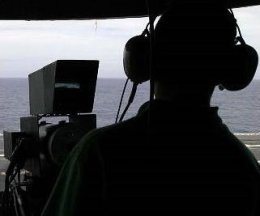 Radio—with images
Radio—with images
The essential concept of television is "radio with photos". To put it differently, in which radio transmits an audio sign (the information being broadcast) through air, television delivers a photo signal too. You most likely realize that these indicators tend to be held by radio waves, invisible habits of electricity and magnetism that race through the environment at the speed of light (300, 000 kilometer or 186, 000 kilometers per second). Think about the radio waves holding information like the waves from the ocean holding surfers: the waves on their own are not the information: the information and knowledge surfs above the waves.
Tv is truly a three-part creation: the television camera that transforms an image and noise into an indication; it transmitter that delivers the sign through environment; together with TV receiver (the television emerge your property) that catches the signal and converts it into picture and noise. television produces moving photos by over and over repeatedly recording nevertheless photos and showing these structures to your eyes so rapidly which they appear to be going. Consider TV as an electronic flick-book. The images are flickering on the display screen so fast which they fuse collectively in your brain to make a moving image (really, though they truly are actually many still photos exhibited one after another).
TV digital cameras
We can see things because they reflect light into our eyes. A regular "nevertheless" camera photographs things by getting this light on light-sensitive film or using an electric light-detector to produce a snapshot of exactly how some thing showed up at a specific minute. A TV camera works in different ways: it offers to fully capture a fresh snapshot over 24 times per second generate the illusion of your moving photo.
Photo: an average video/TV camera. The camera operator stands behind watching a tiny TV display screen that presents precisely what the camera is filming. Remember that the cameraman is not searching through the digital camera lens: he is witnessing a recreation of exactly what the lens is watching on a screen (quite like-looking on display on an electronic digital camera). Photo by Justin R. Blake courtesy of US Navy.
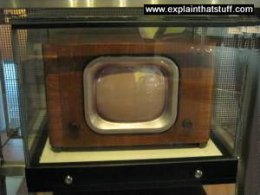 what exactly is the very best way for a TV camera to recapture a photo? If you have ever really tried copying a masterpiece from the wall surface of a form of art gallery into a notebook, you will understand there are several techniques to do so. One of the ways should draw a grid of squares in your laptop, after that copy the important points systematically from each part of the initial picture to the corresponding square associated with the grid. You can work from left to correct and all the way through, copying each grid square consequently. A TV digital camera works exactly like this when it turns a photo into a sign for broadcasting, just it copies the image it views a line at a time. Light-detectors inside the digital camera scan throughout the image line by line, exactly like your eyes checking from top to bottom of picture in an art gallery. This method transforms the image into 525 various "lines of colored light" being beamed through the environment to your house as a video sign. As well, microphones when you look at the television studio capture the sound that goes with the image. This is transmitted alongside the image information as a different audio signal.
what exactly is the very best way for a TV camera to recapture a photo? If you have ever really tried copying a masterpiece from the wall surface of a form of art gallery into a notebook, you will understand there are several techniques to do so. One of the ways should draw a grid of squares in your laptop, after that copy the important points systematically from each part of the initial picture to the corresponding square associated with the grid. You can work from left to correct and all the way through, copying each grid square consequently. A TV digital camera works exactly like this when it turns a photo into a sign for broadcasting, just it copies the image it views a line at a time. Light-detectors inside the digital camera scan throughout the image line by line, exactly like your eyes checking from top to bottom of picture in an art gallery. This method transforms the image into 525 various "lines of colored light" being beamed through the environment to your house as a video sign. As well, microphones when you look at the television studio capture the sound that goes with the image. This is transmitted alongside the image information as a different audio signal.
television transmitters
The louder you shout, the easier it is to know someone well away. Louder noises make bigger noise waves having the ability traveling more before they get absorbed by bushes, woods, and all sorts of the mess around us. The exact same is true of radio waves. To make radio waves which can be strong enough to carry radio and television photos many miles from a TV place to someone's house, you need a really powerful transmitter. That is effectively a giant antenna (aerial), often positioned on top of a hill so it can send signals in terms of possible.
Not everyone receives television signals transmitted through atmosphere this way. For those who have cable television, your television photos tend to be "piped" into your house down a fiber-optic cable-laid beneath your street. For those who have satellite tv, the picture the thing is that was bounced into space and to help it travel from region of the country to the other.
